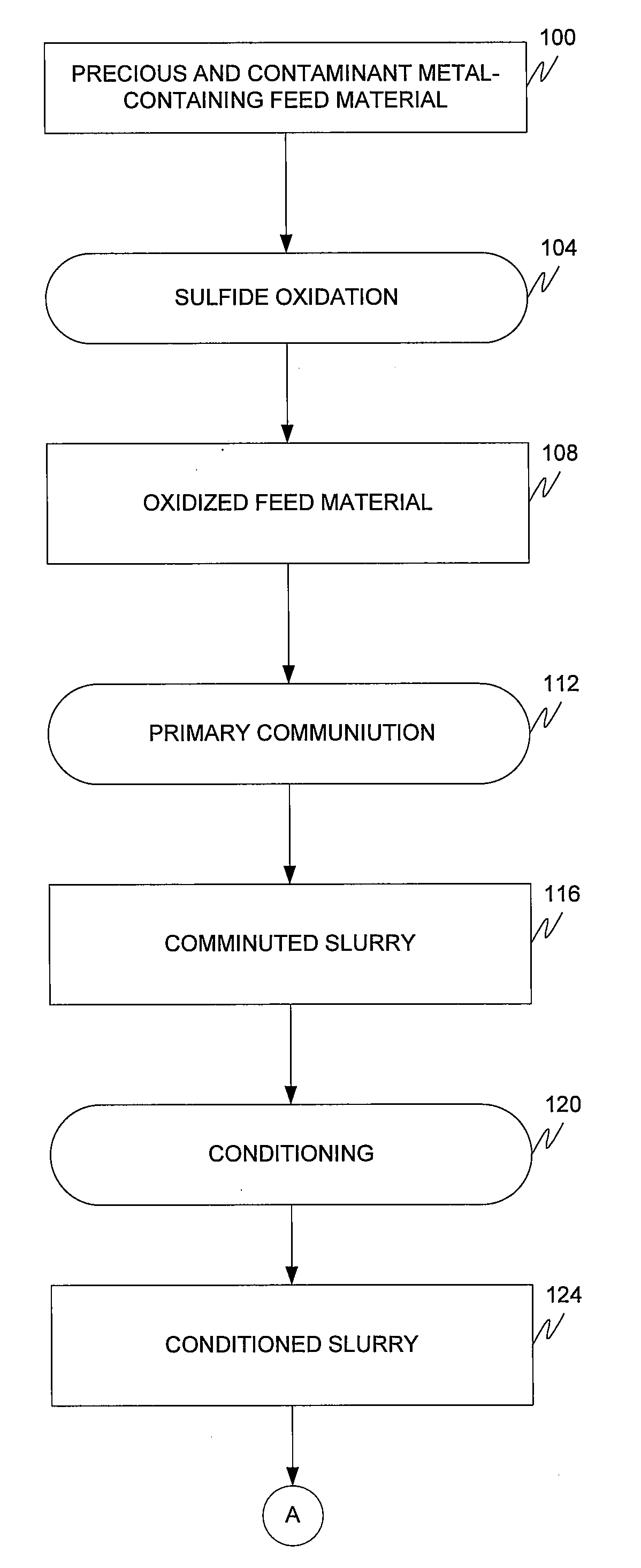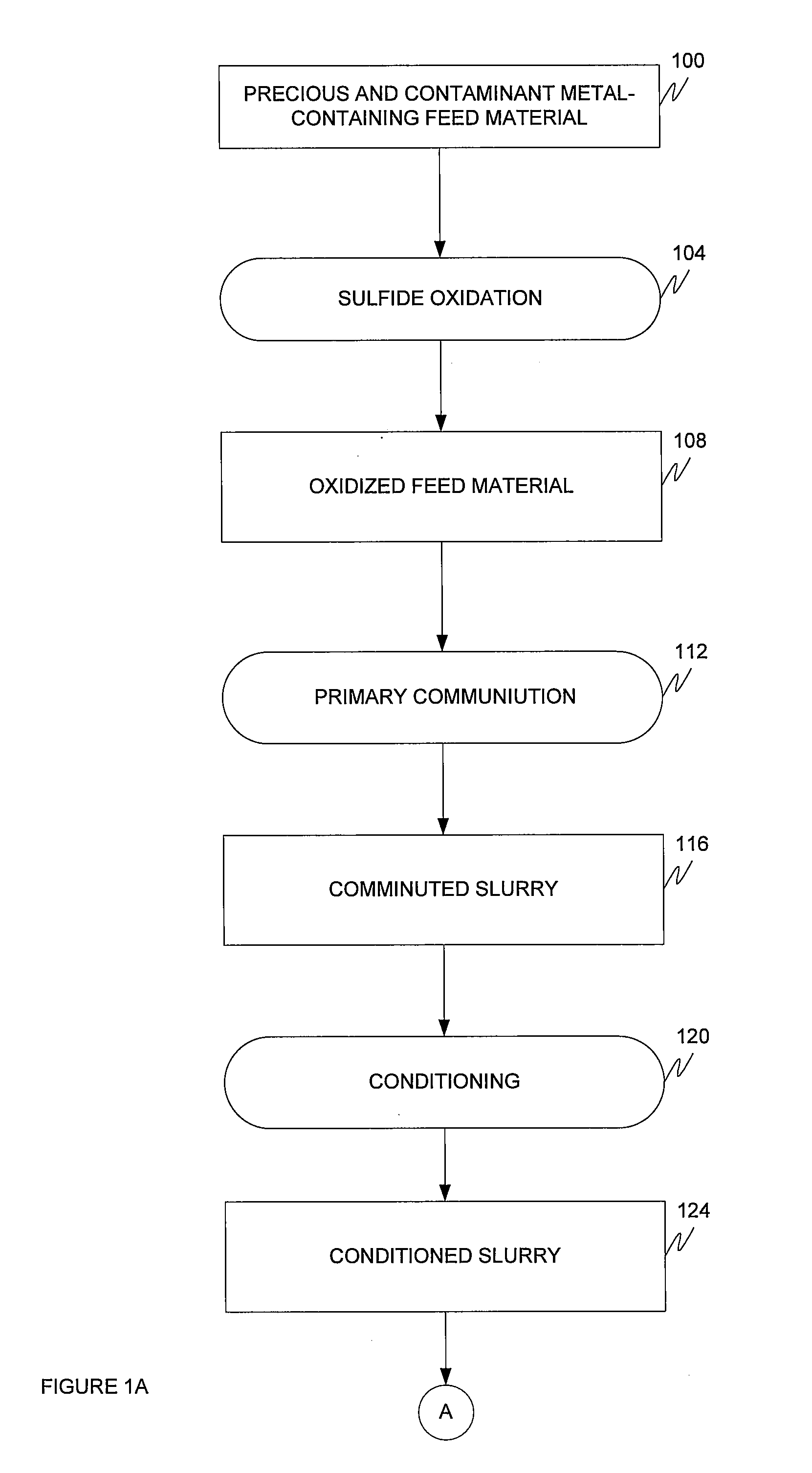Method to improve recovery of gold from double refractory gold ores
a double refractory gold and gold recovery technology, applied in blast furnaces, heating stoves, blast furnace components, etc., can solve the problems of high cost of size reduction required to liberate sulfide refractory gold, present challenges in the extraction and recovery of contained gold, and reduce the flotation behavior of materials. , improve the flotation selectivity of carbonaceous matter, the effect of improving the flotation efficiency
- Summary
- Abstract
- Description
- Claims
- Application Information
AI Technical Summary
Benefits of technology
Problems solved by technology
Method used
Image
Examples
example 1
Acid POX and CIL
[0054]A gold bearing sulfide ore is ground to P80 less than 70 microns. The ore was pre-acidified to remove the carbonate components prior to acid Pressure Oxidation (POX), at 225° C. with oxygen over pressure of 100 psi, a pulp density of 30% and a residence time of 1 hour. The percent sulfide oxidation was typically 97% and the residue discharged from the autoclave contained less than 0.06% sulfide. The autoclave discharge also contained 0.49% Total Carbonaceous Material or TCM, a portion of which contributes to the phenomenon of preg robbing.
[0055]The pH of the discharge slurry was adjusted to greater than pH 10.5 with lime, and gold recovery was performed using cyanidation and Carbon in Leach (“CIL”). Treatment of the discharge by conventional CIL yielded a gold recovery of about 55%. This example illustrates low gold recovery caused by the preg-robbing character imparted by a portion of the TCM material. The feed assays and CIL recoveries are summarized in Table...
example 2
Acid POX, Flotation, CIL
[0056]The same POX discharge used in Example 1 was treated using a two-stage flotation process consisting of a rougher and cleaner flotation, wherein a portion of the preg-robbing TCM is concentrated, as shown in FIGS. 1A and B. The discharged autoclave slurry was ground for about five minutes to remove oxidative film from particle surfaces. Prior to flotation, there was no pH adjustment of the autoclave discharge, and the pulp density was about 20%. The material was then conditioned with about 200 g / t of Cytec C-40 as a dispersant. About 100 g / t of Cytec carbon collector S19979 / S10037 or fuel oil was added. Rougher flotation was performed in a standard 5 litre flotation cell. Rougher concentrate was collected and ground for about 4 minutes followed by one stage of cleaning. The TCM-containing concentrate was collected. The Rougher and Cleaner Tails were collected and CIL tests were carried out on this stream.
[0057]Flotation and CIL test results on acid POX r...
example 3
Alkaline POX, CIL
[0059]The same gold bearing sulfide as used in example 1 was ground to P80 less than 70 microns. The ore is treated by alkaline pressure oxidation, at 225° C. with oxygen over pressure of 100 psi, a pulp density of 35% and a residence time of 1 hour. The percent oxidation was lower than that observed for Acidic Pressure Oxidation in example 1 and the residue discharged from the autoclave contains 0.06 sulfide.
[0060]The pH of the slurry was adjusted to greater than 10.5 and gold recovery was performed using CIL. Treatment of the discharge by conventional CIL yields a gold recovery of 52%. The low gold recovery is due to the preg-robbing character imparted by a portion of the TCM material. The feed assays and CIL recoveries are summarized in Table 3.
TABLE 3Head AssayAlkaline POXElementsBR31DischargeAug / t4.534.6S (T)%1.76S2−%1.700.06S(SO4)%TCM%0.460.49CO3%18.4CIL Residueg / t2.4 to 2.9Au Recovery by CIL%42-52
PUM
| Property | Measurement | Unit |
|---|---|---|
| Fraction | aaaaa | aaaaa |
| Fraction | aaaaa | aaaaa |
| Hydrophobicity | aaaaa | aaaaa |
Abstract
Description
Claims
Application Information
 Login to View More
Login to View More - R&D
- Intellectual Property
- Life Sciences
- Materials
- Tech Scout
- Unparalleled Data Quality
- Higher Quality Content
- 60% Fewer Hallucinations
Browse by: Latest US Patents, China's latest patents, Technical Efficacy Thesaurus, Application Domain, Technology Topic, Popular Technical Reports.
© 2025 PatSnap. All rights reserved.Legal|Privacy policy|Modern Slavery Act Transparency Statement|Sitemap|About US| Contact US: help@patsnap.com



